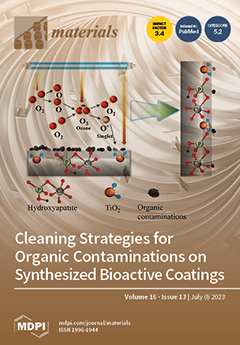Materials, Volume 16, Issue 13 (July-1 2023) – 397 articles
Artificial joints, dental implants, and orthopedic/osseous screws are common applications for titanium, titanium alloys and titanium-based coatings. Bioactive coatings containing titanium oxides and hydroxyapatite (HAP) are obtained through Plasma Electrolytic Oxidation (PEO). Despite the numerous advantages of PEO coatings, the issue of organic contamination often found on bioactive surfaces still needs to be addressed. A coated surface was cleaned using an autoclave, ultraviolet light, radio frequency, air plasma, and UV ozone cleaner. After applying surface cleaning methods, the carbon content decreased from 5.21 at. % to 0.11 at. %. Ozone treatment was the most effective and gentle among the above-mentioned cleaning methods. View this paper
- Issues are regarded as officially published after their release is announced to the table of contents alert mailing list.
- You may sign up for e-mail alerts to receive table of contents of newly released issues.
- PDF is the official format for papers published in both, html and pdf forms. To view the papers in pdf format, click on the "PDF Full-text" link, and use the free Adobe Reader to open them.






